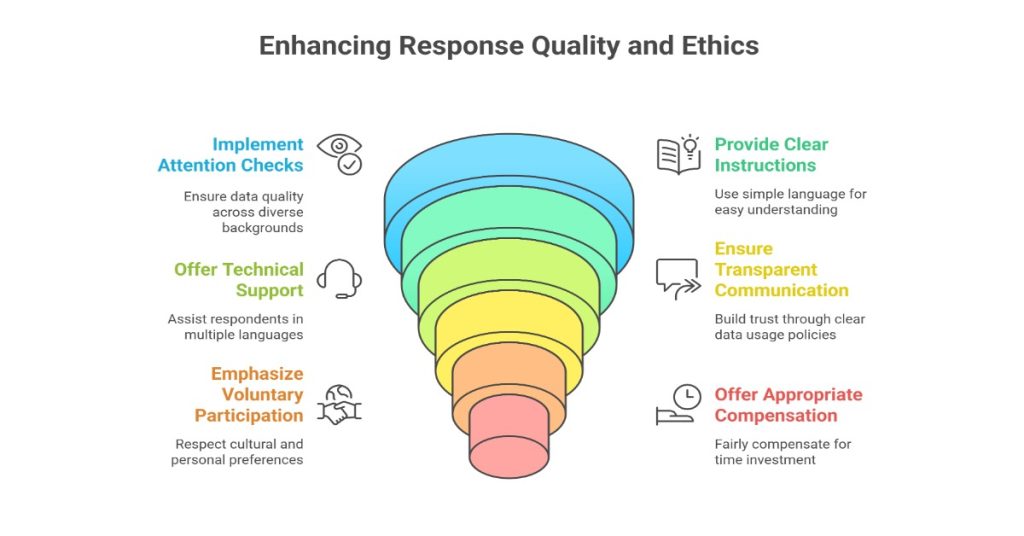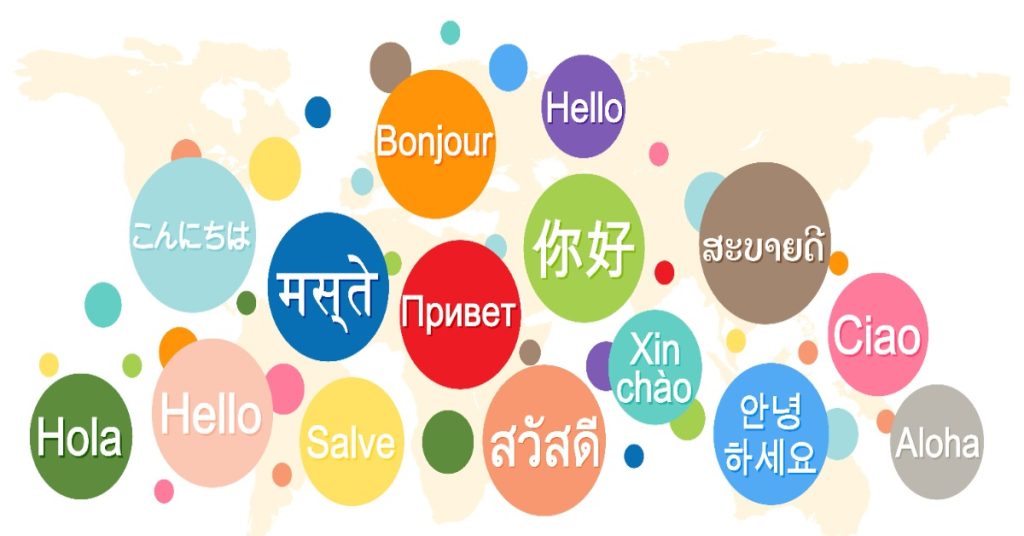In today’s data driven world, gathering insights from diverse populations is crucial for making informed business decisions. However, reaching across different demographic segments presents unique challenges that require strategic planning and execution.
Understanding how to effectively expand your survey reach across various demographics can dramatically improve the quality and representativeness of your research data. This comprehensive guide explores proven strategies to overcome barriers and maximize participation across age groups, ethnicities, income levels, and other demographic segments.
Table of Contents
Understanding the Importance of Demographic Diversity in Survey Research
Demographic diversity in survey research isn’t just about inclusivity – it’s about accuracy and actionable insights. When surveys only capture responses from limited demographic segments, the results may not reflect the true opinions or behaviors of your target population.
Research shows that homogeneous survey samples can lead to skewed results and missed opportunities. For instance, a product survey that primarily captures responses from one age group might miss critical feedback from other generations who use the product differently.
The business impact of diverse survey data extends beyond research accuracy. Organizations that gather comprehensive demographic insights can better tailor their products, services, and marketing strategies to meet varied customer needs.
Strategic Timing and Communication Methods
Optimizing Survey Distribution Timing
When you send your surveys matters significantly for demographic reach. Different age groups and working populations have varying online activity patterns and availability windows.
Mid-morning surveys (10 AM to 12 PM) typically yield higher response rates across most demographics. However, working professionals may respond better to surveys sent during lunch breaks or early evening hours.
Weekend distribution can be particularly effective for reaching parents and busy professionals who have more time to engage with survey content during non-working hours.
Multi-Channel Distribution Strategies
Expanding your survey reach requires diversifying distribution channels beyond traditional email campaigns. Social media platforms offer powerful targeting capabilities that allow you to reach specific demographic segments based on age, interests, location, and behavior patterns.
Phone and SMS surveys remain highly effective for reaching older demographics and populations with limited internet access. These methods provide direct contact and can yield high-quality responses when executed properly.
Print and in-person distribution shouldn’t be overlooked when targeting specific communities or age groups that may be less digitally engaged. Community centers, libraries, and local events provide opportunities for face-to-face survey distribution.

Designing Inclusive and Accessible Survey Content
Language and Cultural Considerations
Creating culturally sensitive surveys requires careful attention to language, imagery, and cultural references. Avoid assumptions about family structures, religious practices, or lifestyle choices that may not apply across all demographic segments.
Use inclusive language that allows respondents to self-identify rather than forcing them into predetermined categories. For gender questions, provide options beyond binary choices and include “prefer to self-describe” options.
Translation quality significantly impacts response rates in multilingual communities. Professional translation services that understand cultural nuances produce better results than automated translation tools.
Question Design and Survey Structure
Start with engaging, relevant questions rather than demographic inquiries. Leading with personal demographic questions can increase bounce rates, particularly among privacy-conscious populations.
Keep surveys concise and focused to prevent survey fatigue. Research indicates that longer surveys see dramatically decreased completion rates across all demographic segments.
Mobile optimization is crucial for reaching diverse demographics. Ensure your survey displays properly on various screen sizes and loads quickly on slower internet connections common in some communities.
Leveraging Technology and Digital Platforms
Social Media Targeting
Platform-specific strategies allow you to reach different demographic segments where they’re most active. LinkedIn effectively reaches professional demographics, while Instagram and TikTok provide access to younger audiences.
Hashtag strategies can expand your organic reach beyond immediate followers. Research relevant community hashtags and trending topics within specific demographic segments to increase survey visibility.
Paid social media advertising offers precise demographic targeting capabilities. Facebook and Instagram ads can target users based on age, location, interests, and behaviors, allowing for highly focused survey distribution.

Email and Digital Outreach
Personalized email invitations significantly improve response rates across all demographics. Use recipients’ names and reference their specific experiences or relationships with your organization.
Multi-touch email campaigns with strategic follow-up sequences can capture respondents who missed initial invitations. Research shows that systematic reminder campaigns can increase participation rates substantially.
Mobile-friendly email design ensures your survey invitations display properly on smartphones, which is crucial for reaching mobile-first demographics.
Measuring and Optimizing Demographic Representation
Tracking Response Patterns
Monitor response rates by demographic segments to identify underrepresented groups in real-time. This allows for mid-campaign adjustments to improve representation.
Analyze completion rates across different demographic groups to identify potential barriers or survey design issues that disproportionately affect certain segments.
Geographic response mapping helps identify regions or communities that may need additional outreach efforts or alternative distribution methods.
Iterative Improvement Strategies
A/B test different approaches within demographic segments to optimize messaging, timing, and incentive strategies. What works for one group may not be effective for another.
Collect feedback on the survey experience itself. Understanding why certain demographics choose not to participate provides valuable insights for future improvement.
Document lessons learned from each survey campaign to build institutional knowledge about effective demographic outreach strategies.

Advanced Targeting Techniques
Behavioral Segmentation
Purchase behavior analysis allows you to target specific demographic segments based on their buying patterns and product usage. This approach can be particularly effective for market research surveys.
Digital behavior tracking (where privacy regulations permit) provides insights into online activity patterns that correlate with demographic characteristics.
Engagement history with previous surveys or marketing communications can inform targeting strategies for different demographic segments.
Collaborative Outreach
Partner with complementary businesses that serve similar demographic segments to expand your survey reach through shared networks.
Influencer partnerships can provide authentic endorsements that encourage participation among specific demographic groups.
Academic collaborations lend credibility to research efforts and can facilitate access to participant networks through university partnerships.
Best Practices for Maintaining Response Quality
Quality Control Measures
Implement attention checks that work across different cultural and educational backgrounds to ensure data quality without creating barriers.
Provide clear instructions in simple language that can be easily understood by diverse educational and linguistic backgrounds.
Offer technical support in multiple languages for respondents who encounter difficulties with digital survey platforms.
Ethical Considerations
Transparent communication about data usage and privacy protections is essential for building trust across all demographic segments.
Voluntary participation should be emphasized, with clear opt-out mechanisms that respect cultural and personal preferences.
Appropriate compensation that reflects the time investment required should be offered fairly across all demographic segments.

FAQs
How do you reach hard-to-reach populations for surveys?
Reaching hard-to-reach populations requires a multi-faceted approach combining traditional and digital methods. Community partnerships represent one of the most effective strategies for accessing underrepresented groups.
Building relationships with local organizations, community centers, and cultural associations provides trusted pathways to specific demographic segments. These partnerships lend credibility to your research efforts and can significantly improve response rates.
Bilingual survey approaches are essential when targeting ethnically diverse communities. Research conducted in social housing areas found that providing questionnaires in multiple languages dramatically improved participation rates among non-English speaking residents.
Mobile-first survey design has become increasingly important for reaching younger demographics and lower-income populations who primarily access the internet through smartphones. Ensuring your surveys are optimized for mobile devices can expand your reach to previously inaccessible segments.
What are effective incentive strategies for different age groups?
Incentive strategies must align with the preferences and motivations of different demographic segments. Younger demographics (ages 18-34) often respond well to digital rewards such as gift cards, app credits, or exclusive content access.
Middle-aged participants (35-54) typically prefer practical incentives like discounts on relevant products or services, while older demographics may respond better to charitable donations made on their behalf or traditional incentives like cash rewards.
Gamification elements can significantly increase participation among younger demographics. Creating quiz-like surveys with points, badges, or leaderboards transforms the survey experience from a chore into an engaging activity.
The key is matching incentive types to demographic preferences while ensuring the rewards are proportional to the time investment required for survey completion.
How do you overcome language barriers in survey research?
Language barriers represent one of the most significant challenges in demographic survey expansion. Professional translation services that understand cultural context produce more accurate and culturally appropriate surveys than machine translation.
Bilingual interview teams can bridge language gaps in phone or in-person surveys. Research in diverse communities shows that having interviewers who speak respondents’ native languages dramatically improves both participation rates and response quality.
Visual aids and simplified language can help overcome literacy barriers that may exist within certain demographic segments. Using clear, simple language and avoiding technical jargon makes surveys more accessible.
Consider offering surveys in the most common languages spoken in your target area. Research in ethnically diverse communities found that providing questionnaires in seven different languages significantly improved overall response rates.

What role do community partnerships play in expanding survey reach?
Community partnerships serve as crucial bridges to hard-to-reach demographic segments. Local organizations possess established trust relationships within their communities that can legitimize your research efforts.
Cultural associations and religious organizations provide access to specific ethnic and cultural groups that might be skeptical of direct outreach from unfamiliar organizations.
Educational institutions can facilitate access to student populations and parent networks, expanding reach across multiple generational demographics simultaneously.
These partnerships often provide valuable insights into cultural sensitivities and preferred communication methods within specific communities, improving both response rates and data quality.
How can survey design accommodate different cultural backgrounds?
Cultural accommodation in survey design requires understanding that different cultures may interpret questions differently or have varying comfort levels with certain topics.
Avoid culturally specific references that may not translate across different backgrounds. Instead, use universal concepts and examples that resonate across cultural boundaries.
Consider cultural attitudes toward privacy and authority when designing demographic questions. Some cultures may be more hesitant to share personal information with unfamiliar organizations.
Respect religious and cultural practices by avoiding scheduling conflicts with significant religious observances and understanding cultural taboos that might affect participation.
Pilot testing with diverse focus groups helps identify cultural sensitivity issues before launching full survey campaigns.
Read More
Case Study: How Thoughtful Survey Design Increased Response Rates by 40%?
10 Question Types That Drive Higher Survey Completion Rates
Get Better Feedback: How to Use Open-Ended Questions in Your Surveys?
Conclusion
Expanding survey reach across different demographics requires a comprehensive strategy that combines cultural sensitivity, technological innovation, and community engagement. Success depends on understanding that different demographic segments have unique preferences, barriers, and motivations for survey participation.
The most effective approach involves deploying multiple distribution channels, partnering with community organizations, and continuously optimizing based on response patterns and feedback. By implementing these strategies thoughtfully and systematically, organizations can gather more representative data that leads to better decision-making and more inclusive outcomes.
Remember that demographic expansion is an ongoing process requiring patience, resources, and commitment to inclusive research practices. The investment in diverse survey methodologies pays dividends through more accurate insights and better understanding of the full spectrum of your target population.

